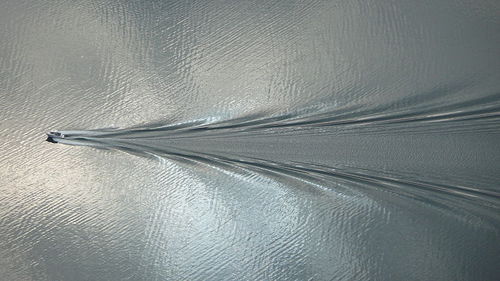Today I’m going to write about coherence and incoherence in waves. Imagine the ripples on the water that come from gently dropping a pebble into a still pool. The ripples on the surface all look the same – circular and moving outwards. If you were very small and floating in the water, you’d bob up and down in a regular, predictable pattern. In physics, we call these sort of waves coherent. You would get a very different picture if the pond was lashed by the wind as rain drops crash down on it – the ripples would have very little order, and a small observer would be tossed around seemingly at random. This is an example of incoherent waves – no point on the surface of the pond looks similar to another point.

Image courtesy of Roger McLassus, CC BY-SA 3.0
Coherence can be a powerful thing. Imagine pushing a someone on a swing – the most effective way to push is rhythmically, in time with the swinging. Pushing in incoherently – in random directions and at random times – will just leave the swingee sitting confused and slightly annoyed. Coherence can be very destructive. The wake from a passing boat can rock smaller boats, and if all that rocking adds up, it can even tip them over.

Image from Wikipedia, CC BY-SA 3.0
One of the most widely used forms of coherent waves is in a laser. Here the coherence is in the electromagnetic waves that we see as light. Lasers have found a use in practically all fields of science, because they are an exceptionally stable source of high intensity, directional light. They can be used for precisely measuring distances, cutting, illuminating, reading data from DVDs and even to move small objects around.
The MagLIF concept I discussed before uses a laser to heat a gas and turn it into a plasma. It’s a good idea – in principle we can make powerful lasers that can deliver enough energy to ionise a gas. But here the beautiful coherence of a laser starts to become its undoing. Just like the wake from a large boat tipping small boats over, the coherent pushing from the electromagnetic field of the laser makes the gas unstable. The laser can self focus, carving small channels for itself through the gas, heating some parts a great deal and leaving the rest cold. In technical terms, the coherence of a laser allows it to couple strongly to unstable modes in the plasma.
However, if we use incoherent light to heat the gas, these instabilities will not be as powerful. The incoherence of the waves means the phases of the laser photons are random, and will average to nothing. X-rays from an imploding array of wires are a good source of incoherent light – we can get lots of energy out, but the chaotic process of the implosion prevents any real coherence. Heating of the gas doesn’t need a coherent light source – you can get pretty warm from an incoherent electrical patio heater!
So whilst coherence is normally a prized property of a system because of the predictable and subtle control it affords us, sometimes it’s best to be a little bit messy to avoid getting out of control.